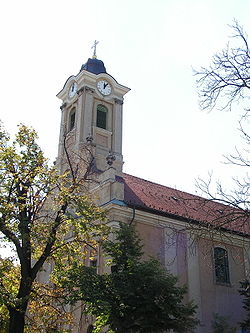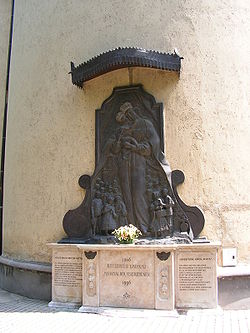
Solymár
Encyclopedia
Solymár is a village northwest of Budapest
, beyond the 3rd and 2nd districts of the city: Nagykovácsi
, Pilisszentiván
, Pilisvörösvár
, Csobánka
, Pilisborosjenő
, and Üröm
. Its picturesque surroundings (hills to the south and east, the highest point is Zsíroshegy at 424m) and good accessibility (the 64 and 164 city buses from Hűvösvölgy, a train from Budapest Nyugati, and coaches from Árpád-híd) have made it a primary destination for prosperous city-dwellers moving to new homes outside of Budapest during the early 2000s.

solymár (more commonly solymász): "falconer
", i.e., the place where the royal falconers live. (Several neighbouring villages were named similarly.) The village prospered during the following centuries and probably hosted a royal hunting castle (Szarkavár), which burnt down after 1561. The advance of the Ottoman Empire
left the village deserted after 1580.
The village was uninhabited until the first new settlers arrived around 1700; first Serbians
and Bulgarians
migrated from the south, to escape the withdrawing Ottoman forces. Soon afterward came German immigrants, recruited by the monarchy from Bavaria and similar southern provinces along the Danube. The Crown paid their transportation and assisted in their getting settled in Hungary; the newcomers were promised they could retain their language and religion (generally Roman Catholic). The monarchy wanted to resettle the area and knew the Germans could restore farmlands along the Danube. Because the settlers continued to speak a form of German and maintained their cultural and religious traditions, they were called die Donauschwaben (Danube Swabians). Their descendants, who were citizens of the Austro-Hungarian Empire and succeeding governments, later formed the great majority of the population in this area and called the village Schaumar in German.
During World War II
, Adolf Hitler
appealed to ethnic Germans in other countries, no matter how long they had resided there. In some areas, ethnic Germans supported his program, but in many cases had loyalty to where they were living. Because part of the Nazi rationale for war was to unite all ethnic Germans and oppress and exterminate other populations, many eastern European countries, such as Hungary, Poland and the Soviet Union, expelled ethnic Germans after the war. About half the population of Solymár was deported to Germany in 1946 as a collective punishment as part of that massive displacement. More than 330 households in Solymár were vacated.
The empty houses were occupied by ethnic Hungarians relocated from other parts of the country (mainly Mezőkövesd
), as well as refugees from Transylvania
. In later years, ethnic Hungarians deported from Czechoslovakia
arrived. Together with the large-scale migration of people from Budapest in the past decade of suburbanization
, ethnic Germans have become a minority of the population. Since 1990 the deportation has been commemorated; a memorial was installed at Templom tér.


Budapest
Budapest is the capital of Hungary. As the largest city of Hungary, it is the country's principal political, cultural, commercial, industrial, and transportation centre. In 2011, Budapest had 1,733,685 inhabitants, down from its 1989 peak of 2,113,645 due to suburbanization. The Budapest Commuter...
, beyond the 3rd and 2nd districts of the city: Nagykovácsi
Nagykovácsi
Nagykovácsi is a small town in the Pilisvörösvári kistérség district of Hungary situated some north-east of the centre of Budapest, in a valley, at an altitude of 340 metres. It is located next to the second district of Budapest...
, Pilisszentiván
Pilisszentiván
Pilisszentiván is a village in Pest county, Budapest metropolitan area, Hungary. It has a population of 4,217 .-References:...
, Pilisvörösvár
Pilisvörösvár
Pilisvörösvár is a town in Pest county, Hungary. It is twinned with Schramberg, Germany.- External links :*...
, Csobánka
Csobánka
Csobánka is a village in Pest County, Budapest metropolitan area, Hungary. Csobánka is located in the Pilis Mountains which is a National Park in Hungary....
, Pilisborosjenő
Pilisborosjeno
Pilisborosjenő is a village in Pest county, Budapest metropolitan area, Hungary. It has a population of 3,475 ....
, and Üröm
Üröm
-References:...
. Its picturesque surroundings (hills to the south and east, the highest point is Zsíroshegy at 424m) and good accessibility (the 64 and 164 city buses from Hűvösvölgy, a train from Budapest Nyugati, and coaches from Árpád-híd) have made it a primary destination for prosperous city-dwellers moving to new homes outside of Budapest during the early 2000s.

History/people
The name of the village is first mentioned in a charter by Béla IV dated 5 May 1266, as Solomar. The most likely etymology of the name is HungarianHungarian language
Hungarian is a Uralic language, part of the Ugric group. With some 14 million speakers, it is one of the most widely spoken non-Indo-European languages in Europe....
solymár (more commonly solymász): "falconer
Falconer
Falconer or The Falconer may refer to:*A person skilled in the art of falconry*Falconer , a family name*Falconer, New York, United StatesIn media:*Falconer , a power metal band from Sweden...
", i.e., the place where the royal falconers live. (Several neighbouring villages were named similarly.) The village prospered during the following centuries and probably hosted a royal hunting castle (Szarkavár), which burnt down after 1561. The advance of the Ottoman Empire
Ottoman Empire
The Ottoman EmpireIt was usually referred to as the "Ottoman Empire", the "Turkish Empire", the "Ottoman Caliphate" or more commonly "Turkey" by its contemporaries...
left the village deserted after 1580.
The village was uninhabited until the first new settlers arrived around 1700; first Serbians
Serbians
Serbians may refer to people who are identified with the country of Serbia, or people of the Serb ethnic group.However it could also be used as the translation of Serbian word "Србијанци" , especially when distinction is made between the two...
and Bulgarians
Bulgarians
The Bulgarians are a South Slavic nation and ethnic group native to Bulgaria and neighbouring regions. Emigration has resulted in immigrant communities in a number of other countries.-History and ethnogenesis:...
migrated from the south, to escape the withdrawing Ottoman forces. Soon afterward came German immigrants, recruited by the monarchy from Bavaria and similar southern provinces along the Danube. The Crown paid their transportation and assisted in their getting settled in Hungary; the newcomers were promised they could retain their language and religion (generally Roman Catholic). The monarchy wanted to resettle the area and knew the Germans could restore farmlands along the Danube. Because the settlers continued to speak a form of German and maintained their cultural and religious traditions, they were called die Donauschwaben (Danube Swabians). Their descendants, who were citizens of the Austro-Hungarian Empire and succeeding governments, later formed the great majority of the population in this area and called the village Schaumar in German.
During World War II
World War II
World War II, or the Second World War , was a global conflict lasting from 1939 to 1945, involving most of the world's nations—including all of the great powers—eventually forming two opposing military alliances: the Allies and the Axis...
, Adolf Hitler
Adolf Hitler
Adolf Hitler was an Austrian-born German politician and the leader of the National Socialist German Workers Party , commonly referred to as the Nazi Party). He was Chancellor of Germany from 1933 to 1945, and head of state from 1934 to 1945...
appealed to ethnic Germans in other countries, no matter how long they had resided there. In some areas, ethnic Germans supported his program, but in many cases had loyalty to where they were living. Because part of the Nazi rationale for war was to unite all ethnic Germans and oppress and exterminate other populations, many eastern European countries, such as Hungary, Poland and the Soviet Union, expelled ethnic Germans after the war. About half the population of Solymár was deported to Germany in 1946 as a collective punishment as part of that massive displacement. More than 330 households in Solymár were vacated.
The empty houses were occupied by ethnic Hungarians relocated from other parts of the country (mainly Mezőkövesd
Mezokövesd
Mezőkövesd is a town in Borsod-Abaúj-Zemplén county, Northern Hungary. It lies from Miskolc and from Eger.-History:The area has been inhabited since the Great Migration. It's likely that the first Hungarian settlement was formed here shortly after the conquest of Hungary, but in 1275 in a church...
), as well as refugees from Transylvania
Transylvania
Transylvania is a historical region in the central part of Romania. Bounded on the east and south by the Carpathian mountain range, historical Transylvania extended in the west to the Apuseni Mountains; however, the term sometimes encompasses not only Transylvania proper, but also the historical...
. In later years, ethnic Hungarians deported from Czechoslovakia
Czechoslovakia
Czechoslovakia or Czecho-Slovakia was a sovereign state in Central Europe which existed from October 1918, when it declared its independence from the Austro-Hungarian Empire, until 1992...
arrived. Together with the large-scale migration of people from Budapest in the past decade of suburbanization
Suburbanization
Suburbanization a term used to describe the growth of areas on the fringes of major cities. It is one of the many causes of the increase in urban sprawl. Many residents of metropolitan regions work within the central urban area, choosing instead to live in satellite communities called suburbs...
, ethnic Germans have become a minority of the population. Since 1990 the deportation has been commemorated; a memorial was installed at Templom tér.
Attractions
- Historic Catholic church and other buildings in the village
- Hilltop ruins of a castle
- On the slope of Zsiros Hill is the opening to the Devil's Hole Cave (Ördöglyuk-barlang), an extensive system approximately 3 kilometres long. It is possible for experienced spelunkers to explore the caves with a guide, but it is not otherwise accessible.

Population
There are 9455 residents, mainly ethnic Hungarians, with a minority of ethnic Germans.Mayors
- 1990–1994: Péter Dercsényi (Alliance of Free DemocratsAlliance of Free DemocratsThe Alliance of Free Democrats – Hungarian Liberal Party is a liberal party in Hungary, led since July 2010 by Viktor Szabadai . The SZDSZ is a member of the ELDR and of Liberal International...
(SZDSZ)) - 1994–2006: László Enczmann (independent)
- 2006– : Kálmán Szente (independent)
External links


